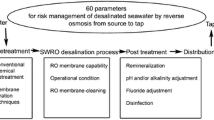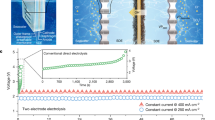Abstract
Two-thirds of the world’s population has limited access to potable water. As we continue to use up our freshwater resources, new and improved techniques for potable water production are warranted. Here, we present a general concept called “salinity exchange” that transfers salts from seawater or brackish water to treated wastewater until their salinity values approximately switch, thus producing wastewater with an increased salinity for discharge and desalinated seawater as the potable water source. We have demonstrated this process using electrodialysis. Salinity exchange has been successfully achieved between influents of different salinities under various operating conditions. Laboratory-scale salinity exchange electrodialysis (SEE) systems can produce high-quality desalinated water at ∼1 mL/min with an energy consumption less than 1 kWh/m3. SEE has also been operated using real water, and the challenges of its implementation at a larger scale are evaluated.

Similar content being viewed by others
References
Achilli A, Cath T Y, Childress A E (2009). Power generation with pressure retarded osmosis: an experimental and theoretical investigation. Journal of Membrane Science, 343(1–2): 42–52
Al-Karaghouli A, Renne D, Kazmerski L L (2010). Technical and economic assessment of photovoltaic-driven desalination systems. Renewable Energy, 35(2): 323–328
Baggett S, Jeffrey P, Jefferson B (2006). Risk perception in participatory planning for water reuse. Desalination, 187(1–3): 149–158
Bitaw T N, Park K, Yang D R (2016). Optimization on a new hybrid forward osmosis-electrodialysis-reverse osmosis seawater desalination process. Desalination, 398: 265–281
Blandin G, Verliefde A R D, Comas J, Rodriguez-Roda I, Le-Clech P (2016). Efficiently combining water reuse and desalination through forward osmosis-reverse osmosis (FO-RO) hybrids: a critical review. Membranes (Basel), 6(3): 37
Brauns E (2010). An alternative hybrid concept combining seawater desalination, solar energy and reverse electrodialysis for a sustainable production of sweet water and electrical energy. Desalination and Water Treatment, 13(1–3): 53–62
Cipollina A, Micale G, Tamburini A, Tedesco M, Gurreri L, Veerman J, Grasman S (2016). Sustainable Energy from Salinity Gradients. Cambridge: Woodhead Publishing, 135–180
Diego C O S (2013). Water Purification Demonstration Project. Project Report
Dolnicar S, Hurlimann A, Grün B (2011). What affects public acceptance of recycled and desalinated water? Water Research, 45(2): 933–943
Dolnicar S, Schäfer A I (2006). Public perception of desalinated versus recycled water in Australia
Dolnicar S, Schäfer A I (2009). Desalinated versus recycled water: public perceptions and profiles of the accepters. Journal of Environmental Management, 90(2): 888–900
Du Pisani P, Menge J G (2013). Direct potable reclamation in Windhoek: a critical review of the design philosophy of new Goreangab drinking water reclamation plant. Water Science and Technology: Water Supply, 13(2): 214–226
Eke J, Yusuf A, Giwa A, Sodiq A (2020). The global status of desalination: an assessment of current desalination technologies, plants and capacity. Desalination, 495: 114633
Elimelech M, Phillip W A (2011). The future of seawater desalination: energy, technology, and the environment. Science, 333(6043): 712–717
Elsaid K, Sayed E T, Abdelkareem M A, Mahmoud M S, Ramadan M, Olabi A G (2020). Environmental impact of emerging desalination technologies: a preliminary evaluation. Journal of Environmental Chemical Engineering, 8(5): 104099
Englehardt J D, Wu T, Bloetscher F, Deng Y, Du Pisani P, Eilert S, Elmir S, Guo T, Jacangelo J, Lechevallier M, Leverenz H, Mancha E, Plater-Zyberk E, Sheikh B, Steinle-Darling E, Tchobanoglous G (2016). Net-zero water management: achieving energy-positive municipal water supply. Environmental Science. Water Research & Technology, 2(2): 250–260
Fan H, Yip N Y (2019). Elucidating conductivity-permselectivity tradeoffs in electrodialysis and reverse electrodialysis by structure-property analysis of ion-exchange membranes. Journal of Membrane Science, 573: 668–681
Fernandez-Gonzalez C, Dominguez-Ramos A, Ibañez R, Irabien A (2019). Current Trends and Future Developments on (Bio-) Membranes. Boston: Elsevier, 111–131
Fritzmann C, Löwenberg J, Wintgens T, Melin T (2007). State-of-the-art of reverse osmosis desalination. Desalination, 216(1): 1–76
Galama A H, Saakes M, Bruning H, Rijnaarts H H M, Post J W (2014). Seawater predesalination with electrodialysis. Desalination, 342: 61–69
Ghernaout D, Elboughdiri N, Alghamdi A (2019). Direct potable reuse: the Singapore NEWater project as a role model. OAlib, 6(12): 1–10
Gilstrap M C (2013). Renewable Electricity from Salinity Gradients Using Reverse Electrodialysis. Atlanta: Georgia Institute of Technology
Grant S B, Saphores J D, Feldman D L, Hamilton A J, Fletcher T D, Cook P L M, Stewardson M, Sanders B F, Levin L A, Ambrose R F, et al. (2012). Taking the “waste” out of “wastewater” for human water security and ecosystem sustainability. Science, 337(6095): 681–686
Guo T, Englehardt J D (2015). Principles for scaling of distributed direct potable water reuse systems: a modeling study. Water Research, 75: 146–163
Indusekhar V K, Krishnaswamy N (1985). Water transport studies on interpolymer ion-exchange membranes. Desalination, 52(3): 309–316
Johnson A S, Hillestad H O, Shanholtzer S F, Shanholtzer G F, Service U S N P (1974). An Ecological Survey of the Coastal Region of Georgia. Atlanta: National Park Service
Kalogirou S A (2005). Seawater desalination using renewable energy sources. Progress in Energy and Combustion Science, 31(3): 242–281
Kurihara M (2021). Current status and future trend of dominant commercial reverse osmosis membranes. Membranes (Basel), 11(11): 906
Lefebvre O (2018). Beyond NEWater: an insight into Singapore’s water reuse prospects. Current Opinion in Environmental Science & Health, 2: 26–31
Leverenz H L, Tchobanoglous G, Asano T (2011). Direct potable reuse: a future imperative. Journal of Water Reuse and Desalination, 1(1): 2–10
Li W, Krantz W B, Cornelissen E R, Post J W, Verliefde A R D, Tang C Y (2013). A novel hybrid process of reverse electrodialysis and reverse osmosis for low energy seawater desalination and brine management. Applied Energy, 104: 592–602
Liu Y, Nie C, Liu X, Xu X, Sun Z, Pan L (2015). Review on carbon-based composite materials for capacitive deionization. RSC Advances, 5(20): 15205–15225
Logan B E, Elimelech M (2012). Membrane-based processes for sustainable power generation using water. Nature, 488(7411): 313–319
Luo F, Wang Y, Jiang C, Wu B, Feng H, Xu T (2017). A power free electrodialysis (PFED) for desalination. Desalination, 404: 138–146
Marks J S (2006). Taking the public seriously: the case of potable and non potable reuse. Desalination, 187(1–3): 137–147
Mekonnen M M, Hoekstra A Y (2016). Four billion people facing severe water scarcity. Science Advances, 2(2): e1500323
Morel A, Zuo K, Xia X, Wei J, Luo X, Liang P, Huang X (2012). Microbial desalination cells packed with ion-exchange resin to enhance water desalination rate. Reviews in Chemical Engineering, 118(1): 43–48
Nam J Y, Hwang K S, Kim H C, Jeong H, Kim H, Jwa E, Yang S, Choi J, Kim C S, Han J H, Jeong N (2019). Assessing the behavior of the feed-water constituents of a pilot-scale 1000-cell-pair reverse electrodialysis with seawater and municipal wastewater effluent. Water Research, 148: 261–271
Patel C G, Barad D, Swaminathan J (2022). Desalination using pressure or electric field? a fundamental comparison of RO and electrodialysis Desalination, 530: 115620
Patel S K, Biesheuvel P M, Elimelech M (2021). Energy Consumption of Brackish Water Desalination: Identifying the Sweet Spots for Electrodialysis and Reverse Osmosis. ACS ES&T Engineering, 1(5): 851–864
Pecson B M, Triolo S C, Olivieri S, Chen E C, Pisarenko A N, Yang C C, Olivieri A, Haas C N, Trussell R S, Trussell R R (2017). Reliability of pathogen control in direct potable reuse: Performance evaluation and QMRA of a full-scale 1 MGD advanced treatment train. Water Research, 122: 258–268
Pellegrino J, Gorman C, Richards L (2007). A speculative hybrid reverse osmosis/electrodialysis unit operation. Desalination, 214(1): 11–30
Pilat B (2001). Practice of water desalination by electrodialysis. Desalination, 139(1): 385–392
Qasim M, Badrelzaman M, Darwish N N, Darwish N A, Hilal N (2019). Reverse osmosis desalination: a state-of-the-art review. Desalination, 459: 59–104
Rajindar S (2015). Membrane Technology and Engineering for Water Purification, 2nd ed. Oxford: Butterworth-Heinemann
Ramon G Z, Feinberg B J, Hoek E M V (2011). Membrane-based production of salinity-gradient power. Energy & Environmental Science, 4(11): 4423–4434
Roman M, Gutierrez L, Van Dijk L H, Vanoppen M, Post J W, Wols B A, Cornelissen E R, Verliefde A R D (2020). Effect of pH on the transport and adsorption of organic micropollutants in ion-exchange membranes in electrodialysis-based desalination. Separation and Purification Technology, 252: 117487
Roman M, Van Dijk L H, Gutierrez L, Vanoppen M, Post J W, Wols B A, Cornelissen E R, Verliefde A R D (2019). Key physicochemical characteristics governing organic micropollutant adsorption and transport in ion-exchange membranes during reverse electrodialysis. Desalination, 468: 114084
Sadrzadeh M, Mohammadi T (2009). Treatment of sea water using electrodialysis: current efficiency evaluation. Desalination, 249(1): 279–285
Semiat R (2008). Energy issues in desalination processes. Environmental Science & Technology, 42(22): 8193–8201
Semiat R, Hasson D (2012). Water desalination. Reviews in Chemical Engineering, 28(1): 43–60
Seto T, Ehara L, Komori R, Yamaguchi A, Miwa T (1978). Seawater desalination by electrodialysis. Desalination, 25(1): 1–7
Singh R, Hankins N P (2016). Emerging Membrane Technology for Sustainable Water Treatment. Boston: Elsevier
Skilhagen S E, Dugstad J E, Aaberg R J (2008). Osmotic power—power production based on the osmotic pressure difference between waters with varying salt gradients. Desalination, 220(1–3): 476–482
Spiegler K S, El-Sayed Y M (2001). The energetics of desalination processes. Desalination, 134(1): 109–128
SMCAPHA, AWWA, WEF(2005). Standard Methods for the Examination of Water and Wastewater. New York: Standard Methods Committee of the American Public Health Association, American Water Works Association, Water Environment Federation
Subramani A, Jacangelo J G (2015). merging desalination technologies for water treatment: a critical review. Water Research, 75: 164–187
Thampy S K, Narayanan P K, Harkare W P, Govindan K P (1988). Seawater desalination by electrodialysis. Part II: a novel approach to combat scaling in seawater desalination by electrodialysis. Desalination, 69(3): 261–273
Valladares Linares R, Li Z, Sarp S, Bucs S S, Amy G, Vrouwenvelder J S (2014). Forward osmosis niches in seawater desalination and wastewater reuse. Water Research, 66: 122–139
Vanoppen M, Blandin G, Derese S, Le Clech P, Post J, Verliefde A R D (2016). Sustainable Energy from Salinity Gradients. Cambridge: Woodhead Publishing, 281–313
Vanoppen M, Van Vooren T, Gutierrez L, Roman M, Croué L J P, Verbeken K, Philips J, Verliefde A R D (2019). Secondary treated domestic wastewater in reverse electrodialysis: What is the best pre-treatment? Separation and Purification Technology, 218: 25–42
Volfkovich Y M (2020). Capacitive deionization of water: a review. Russian Journal of Electrochemistry, 56(1): 18–51
Yangali-Quintanilla V, Li Z, Valladares R, Li Q, Amy G (2011). Indirect desalination of Red Sea water with forward osmosis and low pressure reverse osmosis for water reuse. Desalination, 280(1–3): 160–166
Yip N Y, Elimelech M (2012). Thermodynamic and energy efficiency analysis of power generation from natural salinity gradients by pressure retarded osmosis. Environmental Science & Technology, 46(9): 5230–5239
Youssef P G, Al-Dadah R K, Mahmoud S M (2014). Comparative analysis of desalination technologies. Energy Procedia, 61: 2604–2607
Acknowledgements
This work was supported by the U.S. Department of Interior Bureau of Reclamation (No. R19AC00101). The authors acknowledge Sydney Taylor-Klaus for helping in seawater collection.
Author information
Authors and Affiliations
Corresponding authors
Additional information
Highlights
• Present a general concept called “salinity exchange”.
• Salts transferred from seawater to treated wastewater until completely switch.
• Process demonstrated using a laboratory-scale electrodialysis system.
• High-quality desalinated water obtained at ∼1 mL/min consuming < 1 kWh/m3 energy.
Rights and permissions
About this article
Cite this article
Jarin, M., Dou, Z., Gao, H. et al. Salinity exchange between seawater/brackish water and domestic wastewater through electrodialysis for potable water. Front. Environ. Sci. Eng. 17, 16 (2023). https://doi.org/10.1007/s11783-023-1616-1
Received:
Revised:
Accepted:
Published:
DOI: https://doi.org/10.1007/s11783-023-1616-1




